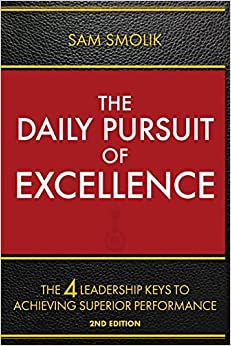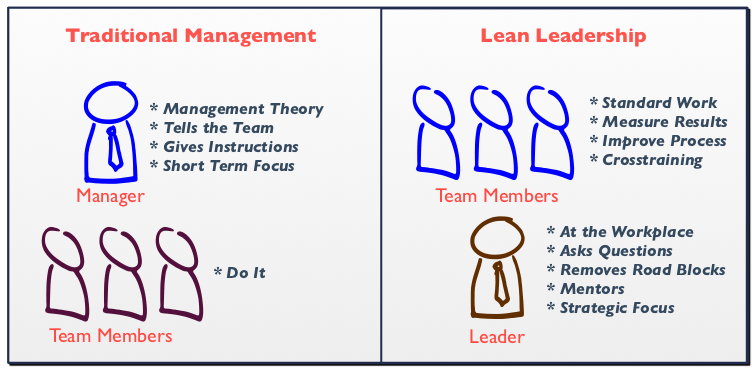The 4 Keys to Achieving Excellence
Like many of you, I’ve had a lifelong quest for learning and for trying to improve my own personal performance and drive excellence in my companies. Excellence is defined as “the quality of being outstanding or extremely good.” Synonyms for excellent and excellence are distinction, first rate, superb, blue chip, choice, first class, five-star, top notch, top shelf, and numero uno.
Excellence is inspiring. I love to watch any type of sporting event and see teams and individuals perform to perfection. I enjoy live music and truly appreciate bands in which every performer is doing his or her part superbly. I’m inspired when I see companies or organizations operate with quality performance. Excellence is obvious—you know it when you see it.
Achieving Operational Excellence begins with creating a compelling case for change and vision for the future. A few bullet points that might go into your vision for Operational Excellence are:
- Fewer people will get hurt.
- Operations will become more consistent and predictable.
- Employee engagement and commitment will increase.
- Costs will decrease.
- All facilities will operate with best practices.
- We will become the best in class supplier to our customers.
- Redundancy and duplication of work will be reduced.
- We will spend less time investigating incidents and more time on incident prevention.
- We will have a consistent framework for documenting the management system.
- Information and knowledge will be easy to access.
- We will have a light touch from corporate with more detail at the sites.
- We will eliminate confusion.
- We will win
During my 50 year career and pursuit of excellence, I’ve learned from my companies, read countless books, attended training sessions and conferences, listened to others, and experimented with my own concepts and those of my teams. Now it’s time to share those learnings with you, but first, a little background information.
I was fortunate to have spent my career with three leading international companies: Dow Chemical, Shell, and LyondellBasell. My career began with seven years in R&D where I learned the importance of technology. I then moved into manufacturing where I learned the importance of Operational Excellence — both from the point of view of being a reliable supplier but also in regard to protecting people, the environment, and preventing process safety incidents. My plan was to complete my career in manufacturing, eventually running global manufacturing for Dow.
However, my career took a sharp turn when Dow promoted me to become the global Vice President of Environment, Health, and Safety (EH&S). The company wanted a person in the role that understood manufacturing, had global experience, and could influence others throughout the organization. I ended up doing this leadership role, and then the same position for Shell globally in their downstream business, and finally with LyondellBasell as part of a team that brought the company out of bankruptcy in 2009. I finished my career coming full circle as Vice President of Americas Manufacturing for LyondellBasell.
In driving Operational Excellence in these global roles, I was able to learn and focus more on the finer aspects of human behavior and what it takes to deliver exceptional performance. I worked with and learned from hundreds of outstanding individuals from around the world, both within and external to the companies I worked for.
Having provided that background for you, I have written a new book entitled The Daily Pursuit of Excellence: The 4 Leadership Keys to Achieving Superior Performance (available on Amazon). I learned so much from people through the years that I wanted to summarize my learnings and share them with others. In writing the book, I began by creating a list of the many tips, tools, techniques, and processes that I found to be successful.
Then I took a reverse engineering approach and summarized the material in a manner that would be most useful to you as a reader, and how I would approach Operational Excellence if I was starting my career all over again or moving to a new company. I also wanted to write a book that leaders could purchase for their employees to help get everyone aligned and on the same page regarding Operational Excellence.
Achieving Operational Excellence takes daily pursuit and a solid plan.
It’s important to look at the big picture and understand how everything fits together in developing a world-class, winning organization. I personally feel that a concept should be as intuitive as possible to help people fully endorse it. If you are going to have an impact on people, you need to explain things in a clear manner and check continually for understanding. A high-level framework helps to organize and frame your intentions and activities, which then allows you to go further into details as appropriate.
Achieving Operational Excellence is essential for accomplishing your ultimate objectives of reliability, customer satisfaction, profitability, and growth. An incredible number of factors are important for an organization to win. A disorganized, shotgun approach never works. It’s helpful to break down the factors into reasonable and understandable components to ensure the path to excellence in performance becomes clear for all and to help with focus.
Profitability, shareholder value, customer satisfaction, Operational Excellence, safety, and winning are all the results of how well an organization performs.
Many organizations set long-term goals for these objectives without specific plans of how to achieve them. Some leaders are very articulate and talk a good game, but don’t deliver the results. You can’t hope and wish your way to good performance, profitability, and winning. To achieve your desired results, it’s vital to focus on the drivers that will most impact your ultimate objectives.
With these thoughts in mind, I created an Operational Excellence Model, which serves as a backbone for everything described in the book. The model works in any type of organization, large or small. To succeed, you must strive for excellence in each of these four components.
Operational Excellence = Leadership + People + Systems + Culture
These four high level concepts are interrelated and are all critically important. The concepts may seem obvious, but it’s incredible how often some get overlooked or don’t receive consistent attention in a proactive manner. Many leaders focus on some of the concepts, but few organizations have a disciplined approach to all four. Success is not built on one or the other, but all four. The chapters in the book are organized to help you understand how these concepts impact each other and also to provide you with tips and techniques under each of the categories. Let’s provide a brief explanation for each element of the model.
- Leadership— Achieving excellence in any organization requires strong leadership. Good leaders begin by creating a strong vision and setting clear expectations for the organization. Naturally, the person at the top of a company, department, and location has the position power and the best opportunity for influence. However, I’ve seen culture driven and changed by individuals down in the organization many times over the years.
- These individuals influence by their personal power as opposed to positional power. I’m talking about leadership at all levels setting the right example and driving change. No matter your position in the organization, you should act like an owner and provide leadership to steer the organization in the right direction. One of the most important aspects of leadership is the ability to influence the behavior of others.
- People—The people in the organization do the work, provide the service, and produce the product. An organization is only as good as its people. Recruit and hire the right individuals. Provide them with the skills and competencies they need. Motivate and inspire them to do their best at all times. Recognize and reward desired behaviors and good performance often.
- Systems—A simplified system of strategy, processes, requirements, technology, and tools helps to build on past learnings and provides a foundation for driving performance to the next level. A management system provides clear expectations and consistency for the way work is done in an organization. Leadership and people create the elements of the system, and then the system provides guidance for the organization.
A good system helps eliminate frustration with individuals by providing them with easy to find tools and instructions they need to do their job. I can’t emphasize simplicity enough when it comes to systems. Don’t overdo it and create unnecessary bureaucracy. Each of you can contribute to improving your organization’s system on a continual basis by giving feedback, providing suggestions, and building on learnings. A management system provides consistency for how work should be done.
- Culture—Culture works both ways: leadership and people create the culture in the organization, and, alternatively, culture affects the way leaders and people in the organization conduct themselves, especially when no one is watching. I’m not just talking about the warm and fuzzy aspects of culture. You want a robust culture of quality performance that constantly inspires every individual to take ownership, excel at what he or she does, eliminate defects, and win. An organization doesn’t stand a chance of being superior without the right culture. A ZERO defect theme is a terrific enabler of the right culture. The culture defines how work is actually done.
Note the subtle but critically important difference between systems and culture. A system describes how work should be done and the culture describes how work is actually done. You can have the best strategy and system in the world, but it’s useless if people aren’t aligned as intended. The culture in the organization is a sign of how people perform on a daily basis. It’s important to continually measure the quality of your culture.
Inherently, everyone agrees and fundamentally understands the importance of Operational Excellence, but where does leadership spend most of its time? In my experience, most of the time spent in corporate leadership teams and board of director meetings is on financial items—business strategy, earnings, cost management, customers, growth, and mergers and acquisitions (M&A). This allocation changes, however, after a major incident or operational problem occurs. The focus then changes to a reactive mode, but it’s often too late; the damage has already been done.
Plenty of people monitor the financial results of a company. Wall Street has a laser focus on quarterly earnings. Countless investor calls and meetings take place throughout the year. The board of directors constantly focuses on earnings and the strategy going forward. This emphasis on cost management and profitability trickles down through the CEO, the leadership team, and the entire organization. Financial metrics are very clear and easy to track.
This financial focus is all perfectly understandable and, of course, very important. The smartest leaders, however, understand that financial results are lagging indicators of actions and performance. The key is a focus on the drivers of performance in a passionate and obvious manner. Every company has strategies and plans, but many companies fail in the execution of those plans. A manufacturing company will never achieve excellence in profitability if there is mediocre performance in operations, reliability, quality, and safety.
I’ve always felt that if I could take away one or two learnings from a book, then buying and reading the book was worthwhile. My wish is that you will have gathered at least a few tips in my book that will help you in your career and make your company better. You should be able to achieve improved reliability, quality, cost control, environmental performance, enhanced customer satisfaction, and safety.
The Daily Pursuit of Excellence contains many personal stories to help illustrate key points. I cover items such as a ZERO defect culture, the importance of simplicity, how to create an understandable management system, numerous tips on human behavior, human factors, attention to detail, communication, work-life balance, understandable writing styles, digitization, metrics, ESG and Sustainability, and so much more. I hope that you and your colleagues will benefit from my life lessons in your pursuit of achieving Operational Excellence.
About the author

Sam Smolik is the author of “The Power of Goal ZERO” which he wrote to capture learnings from a career of global and international executive leadership and board of director experience in multi-billion dollar petrochemical, oil, gas and energy manufacturing companies.
He has experience in manufacturing, supply chain, HSE (environment, health, safety, security), sustainable development, ESG, government agencies and non-government (NGO) organizations, M&A, change management, people development, motivation and culture change.









